Evolution on the smallest of scales smooths out the patchwork patterns of where plants and animals live
- Written by Mark C. Urban, Director, Center of Biological Risk; Professor of Ecology and Evolutionary Biology, University of Connecticut
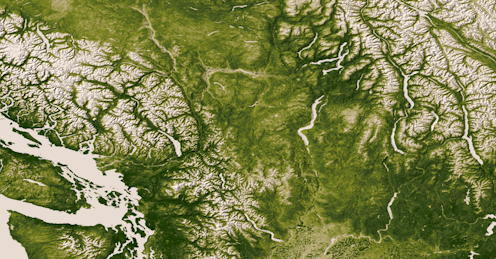 In the Pacific Northwest, even though there are huge variations in environment, the Douglas fir grows everywhere.NASA/NOAA
In the Pacific Northwest, even though there are huge variations in environment, the Douglas fir grows everywhere.NASA/NOAA
The Douglas fir is a tall iconic pine tree in Western North America forming a forest that winds unbroken from the Western spine of British Columbia all the way to the Mexican cordillera. The environmental conditions of Canada and Mexico are obviously very different, but even on much smaller scales – say, the top of a mountain compared with a valley below it – the rainfall, temperature, soil nutrients and dozens of other factors can vary quite a bit. The Douglas fir grows well in so many of these places that it turns a dramatically varied landscape into one smooth, continuous forest complete with all the species it supports.
I am an ecologist and used to think that the Douglas fir was simply a hardy tree, rarely hemmed in by environmental conditions or other species. But recent research done by my colleagues and me suggests that environmental conditions are not all that determines where plants and animals live in a landscape and the patchwork patterns of those distributions. These spatial patterns are also influenced by evolution.
Over time, species often adapt to local conditions, and these adaptations alter how and where they can live. For example, Douglas fir trees might adapt through evolution to thrive on both a dry mountainside and in a wet valley nearby. But my colleagues and I have taken this idea a step further to explore not just how organisms adapt, but how the process of adaptation itself can have profound effects on the patterns of where organisms live in a landscape.
Without adaptation, you might find a mixed patchwork of where species live – a species of insect lives in the valley, but not on the mountains. When Douglas firs adapt to and grow on a dry mountain as well as in the wet valley, they create one continuous forest habitat where two very different landscapes used to exist. The birds, the insects, the deer, the flowers and all the other organisms that live in the forest can also now occupy both the valley and the mountaintop. Adaptation by the Douglas fir created a smoother distribution of species.
Adaptation, it seems, plays a larger role in determining ecological patterns than scientists previously thought.
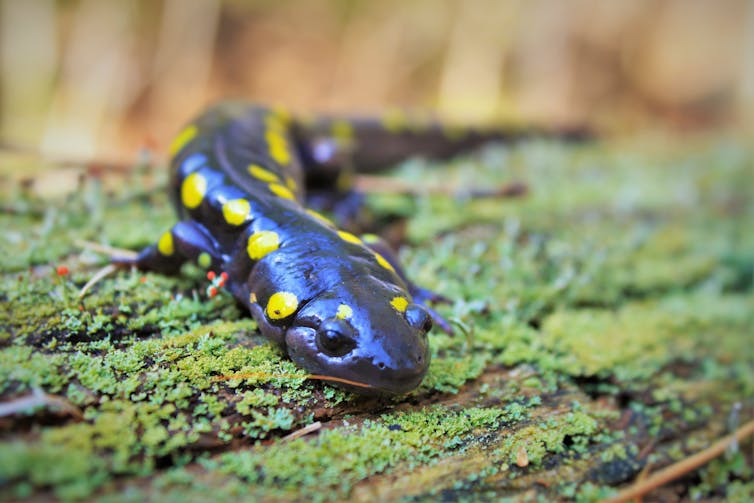 Yellow-spotted salamanders in some ponds get eaten by larger predators, but in others, they adapted to eat more and grow quickly so that they would not be eaten.Mark Urban, CC BY-ND
Yellow-spotted salamanders in some ponds get eaten by larger predators, but in others, they adapted to eat more and grow quickly so that they would not be eaten.Mark Urban, CC BY-ND
A salamander mystery
In 1999, when I was a beginning graduate student in Connecticut, I wanted to understand how a predator called the marbled salamander affected the survival of the smaller yellow-spotted salamander in small temporary ponds. Much like the famous wolves in Yellowstone National Park, the marbled salamander is a keystone predator, and just a few individuals in a pond can determine which other species live there.
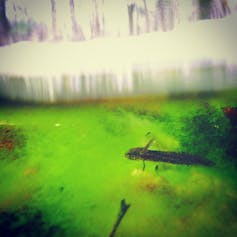 Marbled salamanders are keystone predators in New England ponds, but adaptation by the smaller spotted salamander can dramatically change the composition of the ponds.Mark Urban, CC BY-ND
Marbled salamanders are keystone predators in New England ponds, but adaptation by the smaller spotted salamander can dramatically change the composition of the ponds.Mark Urban, CC BY-ND
I spent months watching these ponds, but however much I tried, the patterns I saw just weren’t making sense. In one pond, the yellow-spotted salamanders survived alongside the marbled predator. But in the next pond over, under nearly identical conditions, the spotted salamanders were quickly reduced to predator poop. I couldn’t find an environmental explanation for this.
To figure out what was driving this unevenness of high and low survival, I collected salamander eggs from ponds where the small salamanders survived alongside the predator, as well as eggs from ponds without predators. I then raised these yellow-spotted salamanders in buckets and looked for differences between them.
I found one surprising difference. The salamanders from ponds with the predatory marbled salamander adapted to the predator by becoming gluttonous – eat and get big so you don’t get eaten yourself.
In these little New England ponds, local adaptation had created spotted salamander populations with very different behaviors to allow them to survive predation from the marbled salamander. But before I could find out more, I finished my doctorate and found myself driving far away from these salamanders to a new job in California.
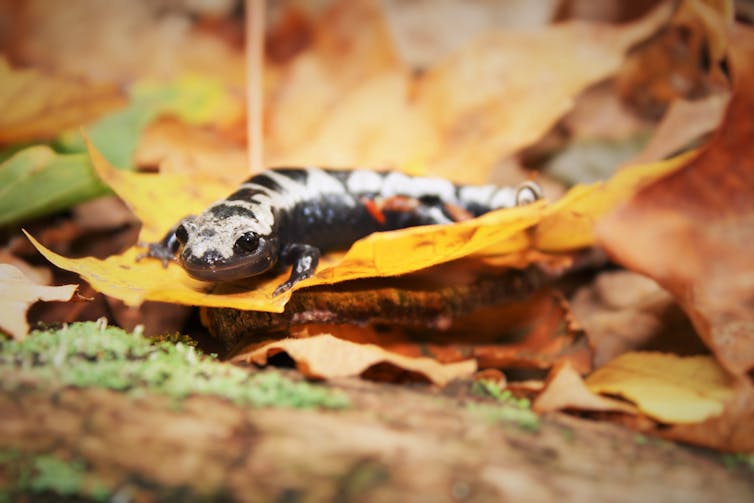 Marbled salamanders were causing local adaptation in another species that was driving dramatic differences in ponds.Mark Urban, CC BY-ND
Marbled salamanders were causing local adaptation in another species that was driving dramatic differences in ponds.Mark Urban, CC BY-ND
Adaptation, not environment, as a cause?
Over the next few years, other ecologists were beginning to recognize that evolution could happen very quickly. In one classic experiment, scientists put algae and a microscopic grazer into a tank together. At first, there were cycles of boom and bust, but after only a few weeks, the algae evolved defenses that prevented them from being eaten and stopped the large swings in population numbers.
This was intriguing. My experience with the salamanders had taught me that evolution could happen not just quickly, but also differently in two nearby and otherwise similar ponds. If evolution affected population patterns in time, maybe it could also affect species distribution patterns in space.
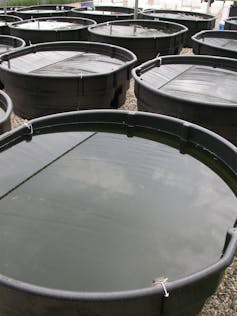 Large cattle watering tanks make for effective experimental ponds.Mark Urban, CC BY-SA
Large cattle watering tanks make for effective experimental ponds.Mark Urban, CC BY-SA
I returned to my salamanders after getting a job at the University of Connecticut. This time, I wasn’t interested just in how salamanders adapted to their ecosystem, but how their adaptations altered the ecosystem itself. I again raised salamanders from high- and low-predation ponds under the same conditions. But this time, I tracked what happened to other species in the artificial ecosystems I had created.
The predatory marbled salamanders eat small crustaceans. But the yellow–spotted salamanders adapted to the predators by eating more of these small crustaceans too. Adaptation by the yellow-spotted salamanders resulted in far fewer crustaceans in the ponds. My experiment showed that this adaptation amplified differences in the numbers of crustaceans between ponds with and without the marbled predator. In this case, adaptation made two ponds more different than they would have been otherwise.
When I compared my experiments with what was happening in the natural ponds, I realized that I had discovered what was driving the perplexing patterns I’d seen years before. Local adaptation, not just the environment or other species, was amplifying the differences in these ponds.
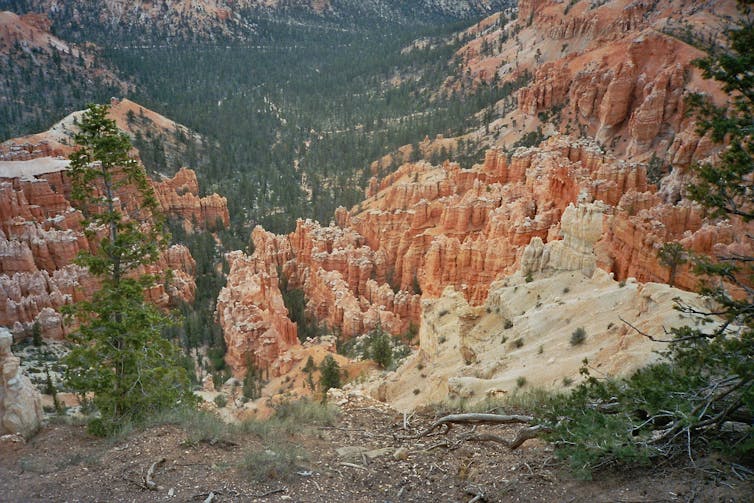 Just like the salamanders, Douglas firs undergo local adaptation that drives broad changes in where organisms live.
Just like the salamanders, Douglas firs undergo local adaptation that drives broad changes in where organisms live.
Adaptation as a universal effect
I began to wonder: If this effect was happening with salamanders, could local adaptation also amplify or dampen spatial ecological patterns in other species? Was this a widespread effect?
Answering this question would require evidence from creatures all around the world. I recruited a bunch of biologist friends to help me sort through thousands of past studies on everything from bacteria to birds and look for evidence that local adaptation was changing the spatial patterns of these species.
Our team gathered information from 500 studies over the past 100 years. We found that, as with my salamanders, adaptation sometimes makes existing differences between places even greater than expected without evolution.
Adaptation can also create patterns where none existed previously. Widespread plants like goldenrods and aspens often evolve chemical defenses that change which insects can eat them. Adaptation creates new patchwork patterns of insect abundances and diversity across fields and forests where none would exist otherwise.
[Deep knowledge, daily.Sign up for The Conversation’s newsletter.]
However, we found that in 85% of cases, adaptation dampened existing ecological spatial patterns. Organisms ranging from the modest apple maggot fly to the grand Douglas fir adapted in ways that reduced the variability of the landscapes in which they lived. Adaptation on small spatial scales smoothed out the patchwork of forests and meadows, populating both hilltops and valleys with the same trees, birds, insects and other organisms. Thanks to adaptation, the world in general is more homogeneous than it would otherwise be.
So next time you find yourself counting down the hours for your car to reach its destination, notice the natural patterns scrolling by your window. Many of these patterns reflect the hidden hand of evolution, which has ironed out the wrinkles and left the world a smoother place.
Mark C Urban receives funding from the U.S. National Science Foundation.
Authors: Mark C. Urban, Director, Center of Biological Risk; Professor of Ecology and Evolutionary Biology, University of Connecticut
